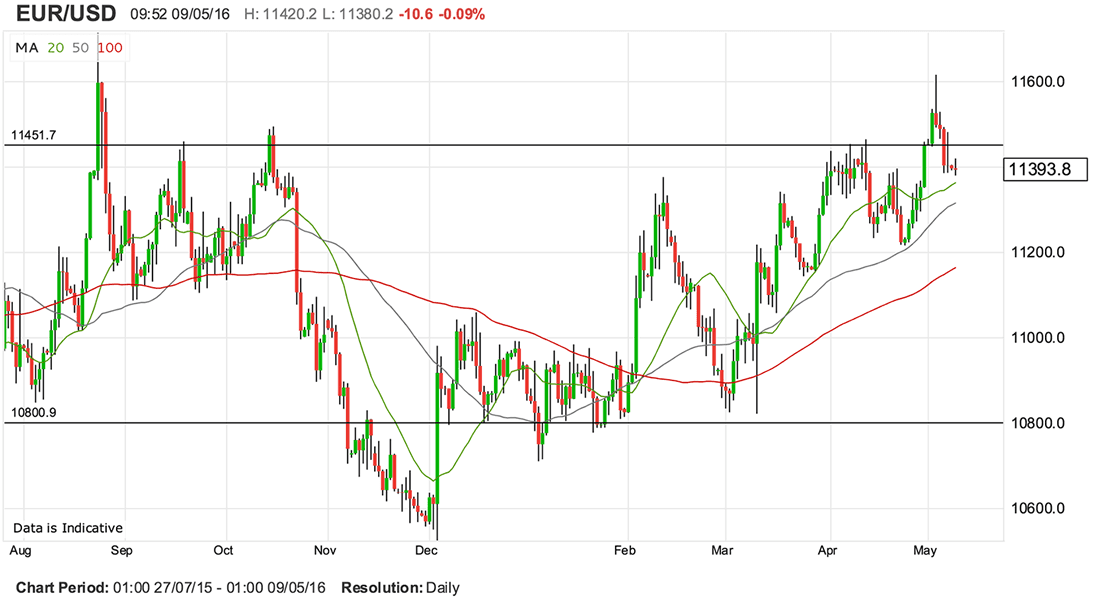Why is the EUR/USD Rate Not Higher? Updated Short-Term Forecasts

We search high and low for the latest views and predictions pertaining to the euro vs dollar exchange rate. Here are what the big name’s in currency forecasting are thinking.
The euro has fallen back below the all-important and technically significant ceiling at 1.1450 against the US dollar.
The declines come despite some positive German factory order data being released at the start of the week in which reported growth of 1.9% in factory output.
This is the best outcome since June 2015 and smashed analyst expectations for an outcome of 0.6%.
Despite the strong data the euro continues to struggle against the dollar confirming that the underlying structure of the actual EURUSD market is important and technical levels must be respected by those with an interest in the pair.
The pair has not spent any notable amount of time above this point since 2014 confirming us to be well within the ranges that define a floor to the euro’s long-term decline.
The question now is whether we are seeing EUR/USD gathering up momentum for a sustained recovery, or whether downside forces are merely looking to reassert themselves and push the euro towards parity.
Here are the latest views:
- Quek Ser Leang at United Overseas Bank, Singapore:
“Indicators are mostly neutral and the current movement is viewed as part of a consolidation phase. In other words, expect sideway trading for today, likely between 1.1360 and 1.1450
“The current movement is viewed as corrective pull-back which has scope to extend lower to 1.1300 but at this stage, a sustained move below this level is not expected.
“Overall, this pair is expected to remain under pressure unless it can reclaim 1.1495.”

- Robin Wilkins at Lloyds Bank:
“A breakdown through 1.1360/1.1320 will add further evidence that the rally to 1.1615 was a false break of the 1.14/1.1465 previous range highs. Supports then lie at 1.1220 and the more important trend line at 1.1050.
A move back through intra-day resistance at 1.1480/1.1530 would re-expose the highs.
“Longer-term we are correcting the downtrend from 1.60 and 1.40, having developed a base at 1.0450. It is not clear whether this will remain in a range, or see a C wave rally up to test monthly resistance in the 1.19-1.23 region.
“So short-term price action is key in determining this, with a move back through 1.16/1.17 the obvious trigger for a move to those upper levels
- Richard Perry at Hantec Markets:
“After EUR/USD played out the volatility in the wake of the Non-farm Payrolls report there has been a degree of settling down that shows little real direction now.
“The rather neutral candle on Friday (just 3 pips down on the day) has been followed by a rather sedate Asian session on Monday morning, so this is a market looking now for the next catalyst.
“The momentum indicators are increasingly benign with the RSI and MACD lines flattening off and the Stochastics shallowing. The intraday hourly chart shows the last three days have found lows around $1.1380 so this is a near term floor and one that comes in just above the old range support band which is now a pivot around $1.1330.
“The Non-farm Payrolls spike has left resistance at $1.1475 which in effect is the old long term range high once again reasserting (was around $1.1465). Recent trends suggests continued correction but the with the market less certain now the pace has slowed.”
- Piet Lammens at KBC Markets in Brussels:
“Technically, EUR/USD broke last week above the 1.1495 MT range top mirroring broad-based USD weakness.
“This break was an important technical warning for further dollar losses and opened the way for a retest of the key 1.1712 (2015 high). However, the USD decline petered out despite mixed US eco data and a poor US payrolls report. We maintain the view that the US economy is strong enough to allow the Fed to implement two rate hikes later this year.
“This is not discounted in the interest rate and FX markets. However, there is currently no trigger for a directional change of course.
“The soft Fed approach, pockets of risk aversion and the Treasury report on currencies pushed USD/JPY to a new lows last week. Verbal interventions from Japan to stop the rise of the yen are likely, but we doubt they will change the trend.”
